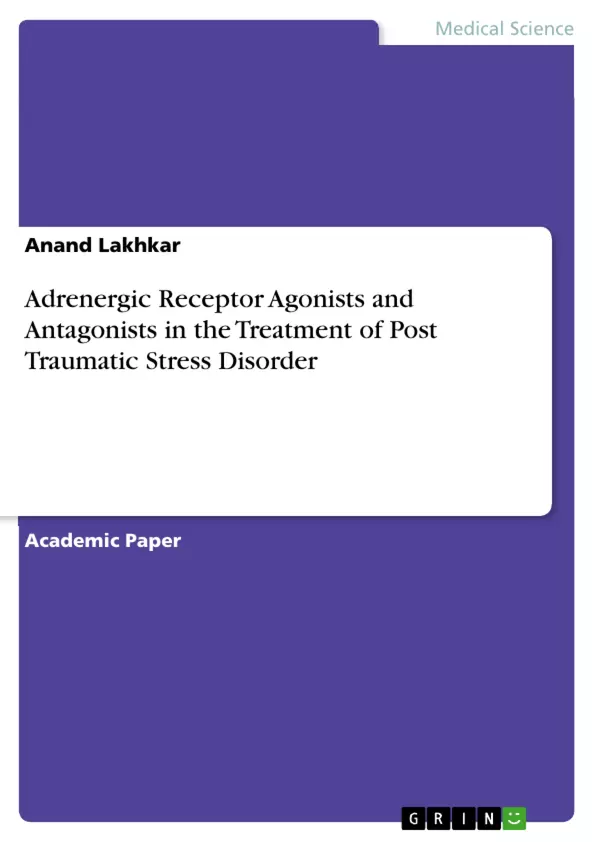Post-traumatic stress disorder (PTSD) is a severe anxiety disorder which can occur in people who experience fear, helplessness, or horror following threat of injury or death. The first section of this review discusses the epidemiology and the risk factors for PTSD. The second section discusses the DSM-IV criteria for diagnosis of PTSD. Adrenergic dysfunction is responsible for most of the hyperarousal and reexperiencing symptoms seen in patients suffering from PTSD. Reduced cortisol and increased levels of corticotrophin releasing hormone also contribute to the adrenergic dysfunction. The third section discusses the role of the dysfunction of the central as well peripheral adrenergic nervous system and how it may be contribute to the reexperiencing and hyperarousal symptoms seen in patients with PTSD.
Dysregulation of the hypothalamus-pituitary-adrenocortical axis results in exaggerated suppression of cortisol levels in PTSD patients and contributes to hyperfunctioning of the adrenergic nervous system seen in those patients. Adrenergic antagonists have emerged as a promising therapeutic intervention to treat the adrenergic dysfunction seen in patients with PTSD. Clinical studies carried out so far have shown that propranolol, clonidine and prazosin have a beneficial role in alleviating some of the symptoms of PTSD. Clonidine and prazosin can be useful for treating traumatic nightmares and hyperarousal symptoms seen in patients with PTSD. Propranolol by blocking the consolidation of memory for traumatic events can be useful for secondary prevention of PTSD in patients who suffered a traumatic event. There is a great need for large scale clinical trials to further evaluate these and newer agents for the growing need for pharmacological treatment of patients with PTSD.
Inhaltsverzeichnis (Table of Contents)
- Introduction
- Risk Factors
- Structural Abnormalities
- Diagnostic Criteria for PTSD
- Role of Norepinephrine
- Cathecholamine Receptors
- Peripheral Norepinephrine in PTSD
- Central Norepinephrine in PTSD
- Catecholamines and Memory
- Relation between Catecholamines and the Sleep Cycle
- Norepinephrine Mechanisms in Hyperarousal Symptoms
- Deregulation of the Hypothalamic-pituitary-Adrenocortical System
- Use of Adrenergic Agonists & Antagonists
- Clonidine
- Prazosin
- Propranolol
- Summary
- Current Pharmacotherapy
- Conclusions
- References
- Abstract
Zielsetzung und Themenschwerpunkte (Objectives and Key Themes)
This literature review aims to explore the role of adrenergic receptor agonists and antagonists in the treatment of Post Traumatic Stress Disorder (PTSD). It examines the existing research on the involvement of norepinephrine in PTSD, particularly its impact on hyperarousal symptoms and memory consolidation. The review also delves into the potential therapeutic benefits of various adrenergic drugs, including clonidine, prazosin, and propranolol.
- The role of norepinephrine in PTSD
- The effects of adrenergic receptor agonists and antagonists on PTSD symptoms
- The efficacy of current pharmacotherapy for PTSD
- The mechanisms by which adrenergic drugs may alleviate PTSD symptoms
- The potential benefits and limitations of using adrenergic drugs in PTSD treatment
Zusammenfassung der Kapitel (Chapter Summaries)
- Introduction: This chapter provides a general overview of PTSD, including its prevalence, risk factors, and the impact of structural abnormalities. It also explores the development of the disorder.
- Diagnostic Criteria for PTSD: This chapter outlines the criteria for diagnosing PTSD according to the DSM-IV.
- Role of Norepinephrine: This chapter examines the role of norepinephrine in PTSD, focusing on its involvement in hyperarousal, memory consolidation, and the sleep cycle. It also discusses the impact of central and peripheral norepinephrine levels on PTSD symptoms.
- Deregulation of the Hypothalamic-pituitary-Adrenocortical System: This chapter explores the dysregulation of the HPA axis in PTSD and its implications for the disorder.
- Use of Adrenergic Agonists & Antagonists: This chapter reviews the literature on the use of adrenergic agonists and antagonists, including clonidine, prazosin, and propranolol, in the treatment of PTSD. It discusses the potential benefits and limitations of these drugs.
Schlüsselwörter (Keywords)
Key terms and concepts explored in this review include Post Traumatic Stress Disorder, norepinephrine, adrenergic receptors, agonists, antagonists, clonidine, prazosin, propranolol, hyperarousal, memory consolidation, sleep cycle, HPA axis, pharmacotherapy, and PTSD treatment.
- Citation du texte
- Anand Lakhkar (Auteur), 2010, Adrenergic Receptor Agonists and Antagonists in the Treatment of Post Traumatic Stress Disorder, Munich, GRIN Verlag, https://www.grin.com/document/449843



